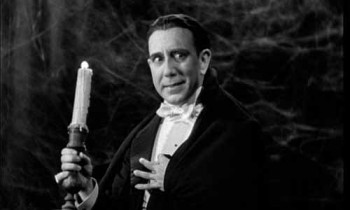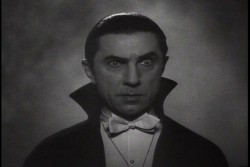
Carlos Villarias as Dracula
As I stated in my review of Dracula, a common practice in Hollywood during the early days of talking pictures was to film a second version of a movie using the same sets and shooting script in a foreign language. At the time, dubbing was not a very refined art, and many considered it cheating anyway. Sadly, most of these films have been lost as they were considered secondary to the English language version and less effort was made to preserve them.
Fortunately, one of the few to survive was the Spanish language version of Dracula.
There is no real reason to go over a synopsis of the film’s plot. It is identical to the English language version that I reviewed last week. Go back and reread that if needed, I’ll wait.
A lot of interest has been given to this version over the years, as many people feel it is in fact superior to the Bela Lugosi classic. Are they right? Let’s find out.
The film was directed by George Melford who was already famous for having directed Rudolph Valentino’s silent classic The Sheik. Working for Universal, Melford directed four Spanish language films. Melford did not speak a word of Spanish and had to use a translator.
Melford also had a competitive streak, at least when it came to Tod Browning and Dracula. Melford and his crew would come in at night after Browning’s crew had wrapped for the day. He would get to look at the dailies with the idea that he would mimic what was shot. Instead Melford decided he could do better and chose to try and improve on what Browning had shot.
Watching this version can be jarring if you are familiar with the English version. Many scenes are identical in look and feel. However, as the movie progresses differences start to become more apparent.
First of all is the pacing. The Spanish version is much better paced, shrugging off the theatrical roots of the material. While the camera work is not as fluid at times as the English version, it makes up for it with grander sweeps and faster movement. There are two scenes in the Browning version that go on a bit long, a battle of wills between Dracula and Van Helsing, and a vampiric seduction of Harker by Mina. Melford improves the pacing by having them happen simultaneously and cutting between them.
Another very clear change is on the close ups of Dracula. In the Browning version, it is always a tight shot of his face with a band of light across his eyes. In Melford’s version, it is a tight close up of just the eyes, or a tight close up of the face and then a jump cut to the close up of the eyes.
Of course we also have to look at the performances by the actors as this is the chief difference between the two.
Carlos Villarias plays Dracula. Of the cast he was the only one allowed to look at the dailies, as the studio wanted him to mimic Lugosi. While there are similarities between the two performances, they are still very different. Villarias plays Dracula more energetically than Lugosi did, and due to less stringent standards for the Spanish audience was able to make the seductive elements of the character more overt. In many ways this is a better performance than Lugosi’s. However, the difference is that Villarias did not have the same commanding presence as Lugosi. So while it might be a better performance technically, it was in no way matching the iconic one given by Lugosi.
Pablo Alvarez Rubio played Renfield. Here I feel that while his performance was equal to Dwight Frye’s, it was different. Manic Frye was menacing, where Rubio was just over-the-top raving. Calm Frye was sympathetic where Rubio became sinister.
Eduardo Arozamena played Van Helsing. Here I feel the performance was flatter compared to the one given by Edward Von Sloan.
The biggest difference was in the female lead. When I reviewed the other version I glossed over the performance of Helen Chandler as Mina. I felt it was just serviceable and did not really stand out. In the Spanish version, Lupita Tovar played the renamed Eva. Her performance was much more dynamic, especially when under Dracula’s thrall. It should be noted that Chandler’s career did not extend beyond the 1930s, whereas Tovar was working through the mid-1940s.
So in the end, I can say that yes, the Spanish version of Dracula is the superior film. Its biggest down fall is that it lacks the iconic performance of Lugosi.
I give it a grade of B-
Hopefully it will not take a year to get back to the Universal Horror movies again. When we do return, we will look at the final member of the Horror trinity, the Wolf Man.



